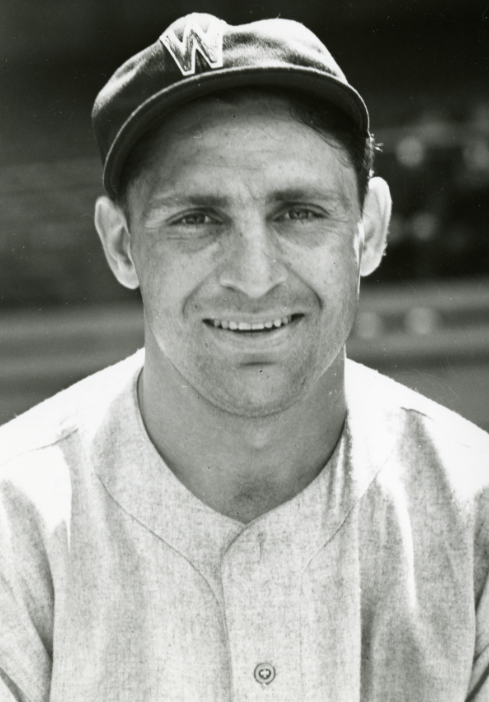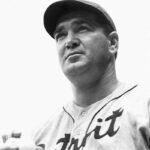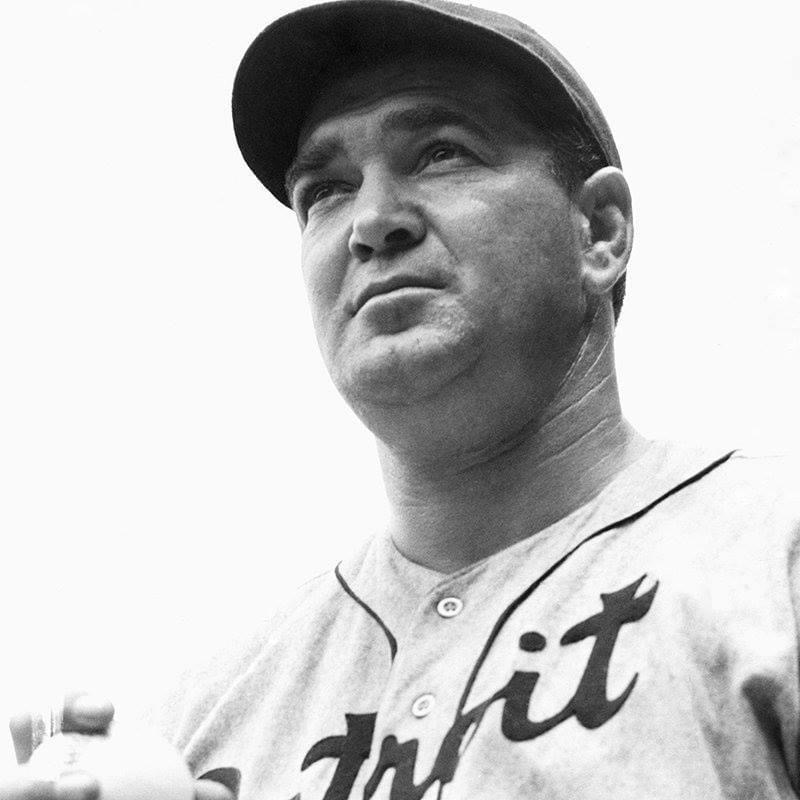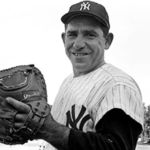Bobo Newsom
Position: Pitcher
Bats: Right • Throws: Right
6-3, 200lb (190cm, 90kg)
Born: August 11, 1907 in Hartsville, SC
Died: December 7, 1962 in Orlando, FL
Buried: Magnolia Cemetery, Hartsville, SC
High School: Hartsville HS (Hartsville, SC)
Debut: September 11, 1929 (6,955th in major league history)
vs. CIN 7.0 IP, 5 H, 5 SO, 2 BB, 2 ER, L
Last Game: September 17, 1953
vs. CLE 1.0 IP, 2 H, 0 SO, 0 BB, 0 ER
Full Name: Louis Norman Newsom
Nicknames: Buck
View Player Info from the B-R Bullpen
View Player Bio from the SABR BioProject
Nine Players Who Debuted in 1929
Rick Ferrell
Doc Cramer
Earl Averill
Bobo Newsom
Larry French
Chief Hogsett
Dale Alexander
Lyn Lary
Eric McNair
All-Time Teammate Team
Coming Soon
Notable Events and Chronology
Biography
Bobo Newsom, a massive, barrel-chested man, toured the major leagues for 20 years, traveling a path that reached eight clubs, rewinding to Washington five times, Brooklyn three times, and the Athletics twice. Bobo was what he called most of his teammates, because he was rarely around long enough to learn their names. He moved through baseball, talkative, boastful, with a supreme self-confidence he usually backed up with a superlative performance, only to have it negated somehow. Three seasons in a row he won 20 or more games, but four times he led the league in losses. He is one of two pitchers to win over 200 games and lose even more.
Misfortune plagued Newsom. He once pitched nine no-hit innings only to lose 2-1 on a 10th-inning hit; he was suspended by his own manager for throwing a spitball; he had his kneecap broken by a line drive yet hobbled on to a complete-game victory. He showed great courage in the 1940 World Series. He had a 21-5 record that year and pitched three complete games for the Tigers in the seven-game Series. His father died suddenly after seeing him win the opener. Tearfully, Newsom dedicated his next start to his dad and won that as well. But his fortunes reversed in Game Seven, as he lost to the Reds, 2-1.@ET-DC@eyJkeW5hbWljIjp0cnVlLCJjb250ZW50IjoicG9zdF90YWdzIiwic2V0dGluZ3MiOnsiYmVmb3JlIjoiTGVhcm4gTW9yZSBhYm91dCB0aGUgdGVhbXMsIHBsYXllcnMsIGJhbGwgcGFya3MgYW5kIGV2ZW50cyB0aGF0IGhhcHBlbmVkIG9uIHRoaXMgZGF0ZSBpbiBoaXN0b3J5IC0gLSAtIC0gLSAtIC0gIiwiYWZ0ZXIiOiIiLCJsaW5rX3RvX3Rlcm1fcGFnZSI6Im9uIiwic2VwYXJhdG9yIjoiIHwgIiwiY2F0ZWdvcnlfdHlwZSI6InBvc3RfdGFnIn19@
Factoids, Quotes, Milestones and Odd Facts
Quotes From Bobo Newsom
“Congratulations on buying pennant insurance.” — wire message sent by Bobo to Brooklyn manager Leo Durocher when the Dodgers purchased Newsom in September of 1942.
“I don’t go in for strikeouts any more. It doesn’t get you anything. Look at that Bob Feller, wearing himself out getting strikeouts. It’s for no good.” — discussing his pitching strategy, 1946
Teams Bobo Newsom Played For
Brooklyn Dodgers (1929-1930)
Chicago Cubs (1932)
St. Louis Browns (1934-1935)
Washington Senators (1935-1937)
Boston Red Sox (1937)
St. Louis Browns (1938-1939)
Detroit Tigers (1939-1941)
Washington Senators (1942)
Brooklyn Dodgers (1942-1943)
St. Louis Browns (1943)
Washington Senators (1943)
Philadelphia Athletics (1944-1946)
Washington Senators (1946-1947)
New York Yankees (1947)
New York Giants (1948)
Washington Senators (1952)
Philadelphia Athletics (1952-1953)
Bobo Newsom in Minor League Baseball
Newsom made his professional debut with Raleigh in the Piedmont League in 1928, going 0-5 before being released and latching on with a team in the East Carolina loop. He won 15 games there and signed with Macon for the 1929 season, where he won 19 games and earned a brief three-game audition with the Dodgers at the end of the year.
He split 1930 between Macon, Jersey City and Brooklyn, where he pitched three innings of relief in his second major league trial.
Despite his brimming confidence, Newsom spent the entire 1931 season in the minors, with Little Rock, where he notched 16 victories and led the league in strikeouts. In 1932, he had moderate success with Albany of the International League, but earned a look from the Cubs, a very brief look – one inning. He was 24 years old and was most likely ready to earn his stripes in the big leagues, but no one was willing to take a chance on him.
In what must have been a rewarding season in many ways, Newsom spent all of 1933 with Los Angeles of the Pacific Coast League. The league was just a step below the majors, and some of the best players were earning more money than they could in the major leagues. A brash veteran of five minor league campaigns, Newsom won 30 games for LA and led the league in K’s. He made sure to get as much as he could from the teamm owners, which included a nice bonus when he won his 30th game.
Finally, someone at the big league level had to take notice of the strong right-hander nicknamed “Buck,” which was an appropriate label considering his love for money.
That someone was the lowly St. Louis Browns, who inserted Newsom into their patchwork rotation for the 1934 season. On a team that finished last in the league in runs scored (nearly two runs less per game than the Yankees), Newsom battled to a 16-20 record. He was in the big leagues to stay. After he started the next season at 0-6, despite an ERA almost exactly the league average, St. Louis dealt him to Washington, where he had his first encounter with the “Grey Fox,” Clark Griffith. The Nats were a team on the slide, but Newsom won 11 games for them in ’35 and went 17-15 in 1936. He was dealt to Boston the following season, and his nomadic ways were beginning to crystalize.
Best Season: 1940
Leading the Tigers trio of 30-something righties that included Tommy Bridges and Schoolboy Rowe, Newsom was the biggest winner in 1940, notching 21 wins against five defeats. He finished second in the league in ERA, with a mark of 2.83. In late September, Newsom pitched two innings of relief in the opener of a doubleheader against the White Sox, and pitched a complete game victory in the second game. In a reversal of fortune, Newsom led the league with 20 losses the following season.
Factoids
Colorful pitcher Bobo Newsom served five different stints with the Washington Senators, and twirled three different times for the St. Louis Browns.
Though he changed teams 16 times in his career, Bob Newsom was only traded four times.
The Durocher Mutiny
In 1943, his second season with the Dodgers, Bobo was rolling along with a 9-4 record when he took the mound in early July to face the Pirates. The Bucs shelled Newsom early in the game, but rather than take it out on his opponents, the agitated pitcher made a scene with his teammates. Storming off the mound after another Pirate run tallied, Bobo got into a heated argument with his catcher, Bobby Bragan, over a dropped third strike that had allowed a run to scamper home. Within a few moments, Newsom was ejected by home plate umpire Larry Goetz, but the pitcher continued his tirade in the dugout face-to-face with manager Leo Durocher. The next day, when the Dodgers learned that Bobo had been suspended by Durocher for “insubordination,” a storm erupted in the clubhouse. Led by Arky Vaughan, the Dodgers walked in to Durocher’s office and tossed their jerseys on his table. The team refused to take the field unless Newsom was re-instated. After Newsom addressed his teammates and heads cooled, the Dodgers, with the exception of Vaughan, all agreed to take the field. Having seen enough of what Newsom could do to a ballclub, Branch Rickey traded Bobo to the St. Louis Browns five days later.
A Brief Time Out
Tiger second baseman Charlie Gehringer, from the book : “I remember him pitching against Greenberg once before he came over to our club. It’s a hot day, he’s got two strikes on Hank, and all of a sudden he just walks off the mound. He didn’t even give the umpire a sign or anything. just took off for the dugout. Everybody said, “Well, where’s he going?” Bobo goes into the dugout, and we see him going over to a big pail of water, and he’s washing his face and he’s toweling it off. All this time Greenberg’s just waiting, probably thinking Bobo had hurt himself. Finally, after he’s all washed up and dried off, Bobo trots out and throws one strike and Greenberg’s out. I’d never seen anyone leave quite like that before. Or since. I forget whether he was with the Browns or Washington then, but Bobo was in a class by himself.”
Description
One writer noted that Newsom was “gifted with a rare sense of humor into which he managed to weave with a seeming lack of fostentation an amazingly exalted opinion of himself.”
Teammate Charlie Gehringer said of Bobo: “He also was probably the biggest character on the Tigers. He was a funny guy. A great jokester. He could do Amos and Andy so well that if you didn’t look at him, you’d think you were hearing the radio. He was always pulling some trick, especially on Schoolie. Schoolie wasn’t too quick with a repartee, so Bobo was always getting the best of him. Nailed his spikes down to his locker once, and things like that. Just drove Schoolie crazy.”
“Good pitcher, though,” Gehringer continued, “he probably was on more ball clubs than anybody that ever pitched, but he certainly had a great arm and a great heart for the game. Pretty good beer drinker, but other than that, he really put it all out.”
Nicknames
Buck
Early in his career, Newsom acquired the nickname “Buck” while pitching in the minors. Later, he adopted “Bobo” as his alias, and he loved to talk about himself in third-person, like: “Bobo thinks he’s hungry,” or “Bobo really has his sinker working today, fellas.” It got to the point where actually called everyone else Bobo as well, which made it nearly impossible to conduct an interview with him. “Bobo” was sort of a character that Louis Newsom played. Every spring training he would arrive with glove in hand and announce to his teammates that he would have the best season of his career and be the sharpest pitcher in baseball. “Bobo” was confident and full of himself. he remained Bobo all season long. When the schedule came to a conclusion, Newsom would retreat home, resume an anonymous off-season as Mr. Louis Newsom and wait for spring to come back around.
Similar Players
No one really compares to Bobo, he was one of a kind. David Wells has some of the same personality traits, in that he and Newsom both loved the limelight, loved to pitch, relied mostly on breaking balls, and pitched well past the time that their bodies seemed suited for the task.
Post-Season Appearances
1940 World Series
1947 World Series
Post-Season Notes
After Newsom pitched for the Yankees in 1947 and helped the team win the World Series with two games of relief, he was voted just a 3/4 share of the World Series money by his teammates. In the off-season, when he was asked for his ring size, Newsom snapped, “Don’t make my ring like the others. Put a three-quarter diamond on it.”
Feats
On May 18, 1938, Newsom struck out six consecutive batters to equal an American League record. Unfortunately, Joe DiMaggio belted two homers, and the Yankees defeated Newsom’s Browns, 11-7.
Pitching Feats
Notes
Newsom was regarded as one of the best negotiators of his era, and he rarely backed down in a salary dispute. He and Senators owner Clark Griffith had numerous disputes, and eventually, their friendship, which was once very strong, disintegrated… Newsom led the league in losses four times during his career and won 20 games three times.
All-Star Selections
1938 AL
1939 AL
1940 AL
1944 AL
In 1938, Bobo Newsom won 20 games while toiling for the lowly St. Louis Browns, who went 55-97 that year. Making the feat all the more unlikely was Newsom’s astronomical 5.08 earned run average, the highest in history by a 20-game winner. All told, the big righty went 20-16 with 226 Ks and paced the American League in innings (329 ⅔), complete games (31), and home runs allowed (30). Newsom’s performance didn’t go unnoticed – he finished fifth in MVP balloting.
Such odd stat lines were commonplace during the hitter-happy 1930s. Ray Kremer, who led the National League in wins (20) and ERA (2.67) in 1926, once again paced the circuit with 20 victories in 1930, albeit with a 5.02 ERA. In 1937, Tigers right-hander Roxie Lawson went 18-7 despite a sky-high 5.26 ERA; his .720 winning percentage is the best single-season mark by a hurler with an ERA over five.
Getting back to Newsom, he followed the 1938 season with another 20-win campaign, though this time posted a respectable 3.58 ERA. Bobo’s most impressive season came with the 1940 Detroit Tigers; he went 21-5 with a 2.83 ERA and topped it off by going 2-1 with 17 Ks and a 1.38 ERA in the World Series.
Noted for his durability, Newsom pitched for nine teams over parts of 20 big-league seasons, routinely ranking among the circuit leaders in innings pitched, complete games, and shutouts. He won 10 or more games 14 times, finished among his league’s top three in strikeouts nine times and, most dubiously, posted ERAs of 4.00-plus on 11 occasions. (Newsom’s career spanned from 1929 to 1953, making him one of 11 pitchers to play in four decades.)
Though the peripatetic hurler led the American League in losses four times, it wasn’t always his fault. Pitching for the Philadelphia A’s in 1945, “Buck” compiled a 3.29 ERA – 69 points lower than his career average (3.98) – in 257 ⅓ innings, yet finished the year with a dismal 8-20 record. For his career, Newsom won 211 games and lost 222 others, making him the only man besides Jack Powell (245-254) to compile 200 wins while posting an overall losing record. — BK2
◾Sources: Nemec, David, and Pete Palmer. “1001 Fascinating Baseball Facts.” Stamford, CT: Longmeadow, 1994. + https://www.digitalcommonwealth.org + https://www.baseball-reference.com + sabr.org
Other Resources & Links
More Newsom Pages
View Player Info from the B-R Bullpen
View Player Bio from the SABR BioProject
If you would like to add a link or add information for player pages, please contact us here.









